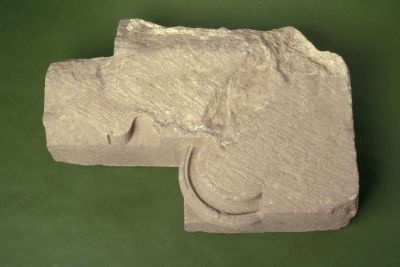
Roof tiles

Fifty-nine fragments of stone roof tile [Photo 0512], mainly derived from a medium-grained micaceous sandstone of the Lower Old Red Sandstone, were excavated at this site. It has been suggested that the most likely source may have been a quarry in Aberlemno area (Stones 1989, 148). In the Angus area, the use of this type of slate was current until at least the 18th and 19th centuries, and examples can still be seen on buildings of that date and earlier, for example Claypotts Castle, near Dundee and an outbuilding at Braehead Cottage, Finavon Castle (G. Stell, pers. comm.).

The roof tiles include a virtually complete example (490 x 485 x 33mm) which had been incorporated within the west wall of the west range (AER). Other complete examples were 305 x 120 x 20mm, 220 x 180 x 13mm and 210 x 190 x 13mm. The variation in sizes reflects the standard practice of grading the size of the slates over the roof surface (Mellor and Pierce 1981, 67-70). The slates were hung directly over the rafters [Photo 0115] and supported by either wooden or iron pegs. Several of the stone tiles have iron staining around the fastening holes. Each course of slate was sealed to the underlying one by means of a strip of mortar, which also provided a waterproof finish.
Building stonework


Eleven fragments of building stone were recovered from this excavation. Most of the worked stone remains in situ at the site. A pair of mouldings for what was probably a door [4, 5; Photo 0209, Photo 0212] were removed from the site as they were considered vulnerable to the building work which was to take place at the site. Other worked stone fragments include a quoin with roll moulding or filleted roll [1], a sill fragment [0003], and a fragment of scroll moulding [6]. No re-used building stonework was recovered from the structures built on the site in the 18th and 19th centuries.
This assemblage is small compared, for example, to the excavations at St Nicholas East Kirk in 2006 (Cameron forthcoming a). This may be due to the complete and thorough dismantling of the Carmelite buildings. The door mouldings had been covered in the medieval period with several cobbled surfaces and would have been below ground at the Reformation. They were probably left as they were either not visible or removal would involve some digging.
The petrography and origin of the building stones
The samples from the rubble packing within the N church wall (Samples 1, 2, 3 and 4; AJB; Phase 5a) are very similar and likely to come from the same source. They are medium to coarse grained sandstones (Samples 1, 3, 4) or fine grained (Sample 2). The rock is a lithic sandstone with a high proportion (c 50% in coarse sandstone) of volcanic fragments and feldspars derived from the erosion of lava flows. The other major constituent is quartz, and there is evidence that carbonate cement has been present, but is now absent due to dissolution. In the local context these rocks compare well with purple tuffaceous sandstones exposed at Cowie Harbour, Stonehaven, and this is a reasonable source for the material, and the closest distance from Aberdeen where this material could be obtained. Thus a quarry, or the coastal outcrop in the Stonehaven Group of the Lower Old Red Sandstone (age is Late Silurian) is the probable source. There are no other local alternatives.
Two samples of pink sandstone chips from a floor surface inside the church (Sample 21, layer A579; Sample 23, layers A617 and A618) (Phase 5d) are of a fine-grained, well sorted quartz-rich sandstone, with minor (c 5%) k-feldspar. The rock retains a high level of porosity (c.15%). The most likely source for these rocks is the Permo-Triassic sandstones of the Elgin-Hopeman-Lossiemouth area. This sandstone has been used extensively as a building stone up to the present day, and this could be an early record of such use. Slightly further afield, the Jurassic sandstones of the old quarries at Strathsteven Cliffs, Brora, on the NW shore of the Moray Firth are composed of a similar sandstone. However there is no evidence in the sections of the characteristic Jurassic fossils (a type of sponge spicule) which occur in these sandstones. Thus it is probable that these two samples are from the Permo-Triassic of the Elgin area, the Hopeman or Lossiemouth sandstones being the most likely candidates.
Internet Archaeology is an open access journal based in the Department of Archaeology, University of York. Except where otherwise noted, content from this work may be used under the terms of the Creative Commons Attribution 3.0 (CC BY) Unported licence, which permits unrestricted use, distribution, and reproduction in any medium, provided that attribution to the author(s), the title of the work, the Internet Archaeology journal and the relevant URL/DOI are given.
Terms and Conditions | Legal Statements | Privacy Policy | Cookies Policy | Citing Internet Archaeology
Internet Archaeology content is preserved for the long term with the Archaeology Data Service. Help sustain and support open access publication by donating to our Open Access Archaeology Fund.